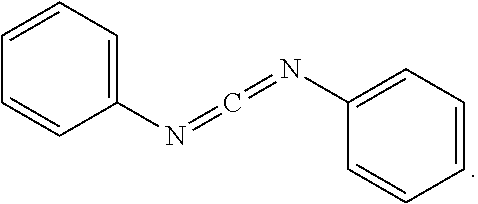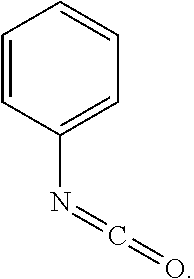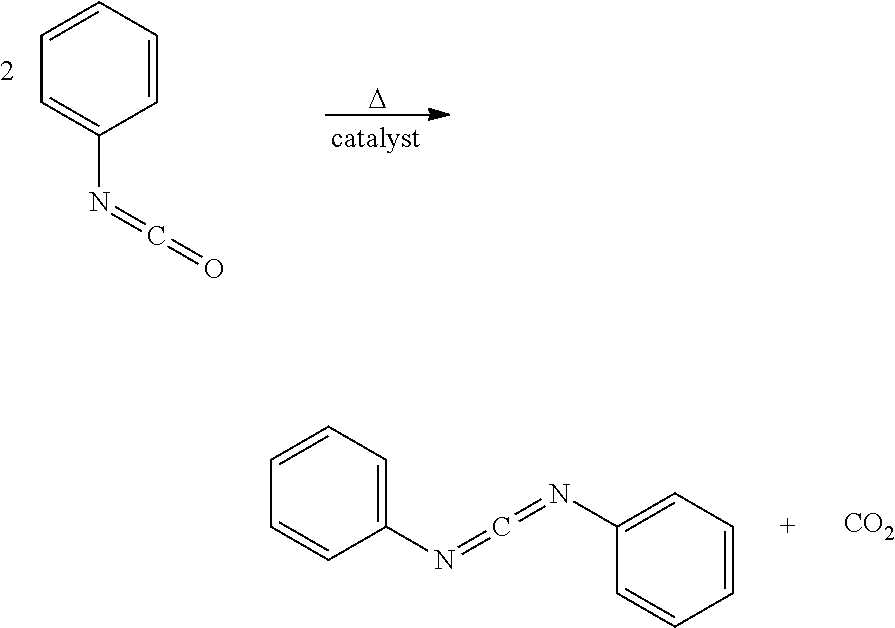Method of preparing a polycarbodiimide polymer and polycarbodiimide polymer prepared thereby
a polycarbodiimide and polymer technology, applied in the field of producing a polycarbodiimide polymer, can solve the problems of significant reduction of potential applications for polycarbodiimides, low molecular weight, and high variation in the molecular weight distribution of polycarbodiimides, and achieve excellent physical properties and excellent stability
- Summary
- Abstract
- Description
- Claims
- Application Information
AI Technical Summary
Benefits of technology
Problems solved by technology
Method used
Image
Examples
example 1
[0108]25.13 grams of Initial Compound 1 are disposed in a dried 3-neck 100 mL round bottom flask under a steady stream of nitrogen. The flask is equipped with a condenser and stir bar and the temperature of the flask is increased from ambient temperature to about 106° C. Nitrogen is bubbled into the liquid, and 0.05 grams of the Carbodiimidization Catalyst and 0.05 grams of the Stabilizing Agent are disposed into the flask. The contents of the flask are stirred at 106° C. for 90 minutes to form Precursor Compound 1. 24.87 grams of Diisocyanate Compound are disposed in the flask while the contents of the flask, i.e., the Precursor Compound, are heated at 106° C. The addition of the Diisocyanate Compound results in the formation of a reaction mixture in the flask. Rapid bubbling is observed in the reaction mixture, which is attributable to the formation of carbon dioxide. The contents of the flask have a temperature less than 100° C. due to the addition of the Diisocyanate Compound, w...
example 2
[0109]369.0 grams of Initial Compound 1 are disposed in a dried 4-neck 1 L round bottom flask under a steady stream of nitrogen. The flask is equipped with a condenser, a mechanical stirrer, and a thermocouple. The temperature of the contents of the flask is increased from ambient temperature to about 106° C. Nitrogen is bubbled into the liquid, and 1.5 grams of the Carbodiimidization Catalyst and 1.5 grams of the Stabilizing Agent are disposed into the flask. The temperature of the flask increases to about 112° C. because of the exothermic reaction associated with the formation of Precursor Compound 1 from Initial Compound 1. The contents of the flask are stirred at 106° C. for 60 minutes to form Precursor Compound 1. An IR measurement after 60 minutes confirms that the NCO groups of the Initial Compound 1 are consumed. 628.0 grams of Diisocyanate Compound are disposed in the flask while the contents of the flask, i.e., the Precursor Compound, are heated at 106° C. The addition of ...
example 3
[0110]9.87 grams of Initial Compound 2 and 35.0 grams of Diisocyanate Compound are disposed in a flame dried round bottom flask (250 mL) fitted with a stir bar, thermocouple, condenser, and nitrogen sparge. Initial Compound 2 is disposed in the flask prior to Diisocyanate Compound. Upon addition of the Diisocyanate Compound, the temperature of the flask increased (via exotherm) from room temperature to about 92° C. and returned to about room temperature after 1 hour. The contents of the flask were analyzed via IR after 40 minutes and after 3.5 hours, with no change in the IR spectra. As such, Precursor Compound 2 is formed in the flask from Initial Compound 2 and Diisocyanate Compound. 37.49 g of Solvent are disposed in the flask and the temperature is raised to about 90° C. 0.19 grams of Carbodiimidization Catalyst and 0.20 grams of Stabilizing Agent are disposed in the flask to form a reaction mixture. The temperature of the reaction mixture is raised to about 106° C. for 1 hour a...
PUM
| Property | Measurement | Unit |
|---|---|---|
| temperature | aaaaa | aaaaa |
| time | aaaaa | aaaaa |
| temperature | aaaaa | aaaaa |
Abstract
Description
Claims
Application Information
 Login to View More
Login to View More - R&D
- Intellectual Property
- Life Sciences
- Materials
- Tech Scout
- Unparalleled Data Quality
- Higher Quality Content
- 60% Fewer Hallucinations
Browse by: Latest US Patents, China's latest patents, Technical Efficacy Thesaurus, Application Domain, Technology Topic, Popular Technical Reports.
© 2025 PatSnap. All rights reserved.Legal|Privacy policy|Modern Slavery Act Transparency Statement|Sitemap|About US| Contact US: help@patsnap.com



